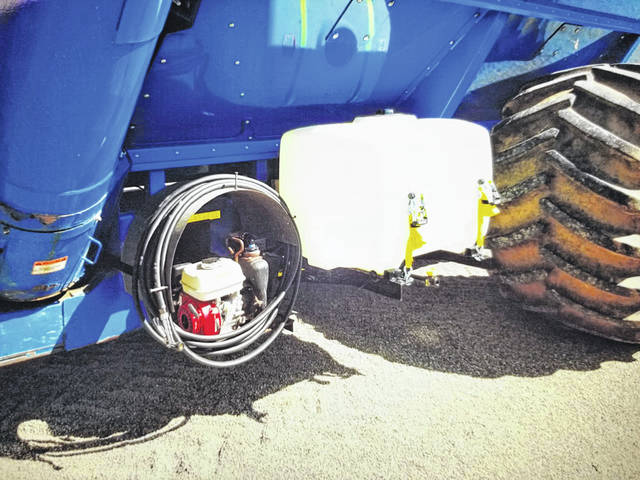
A local farmer, Ron Ratliff, recently stopped by the Washington Fire Department with a photo of a safety idea that he and his family incorporated into their farming equipment.
Fire chief Tim Downing explained, “Being that I am from Cleveland originally and have spent the last 24 years living in the City of Washington Court House, I have no experience, other than fighting fires, on farms and in farm fields. Mr. Ratliff explained some of the costs associated with a loss of a combine during the harvest season as well as the idea he and his son had to minimize losses if they were to have a fire.”
This information is in reference to combine fires and field fires. Fall harvest is the time of year most of these types of fires occur.
As Ratliff explained, most farms only have one combine and “very few” may have up to three.
He went on to explain that these machines cost anywhere from $500,000 to $1 million. For a small farmer to have a fire in a piece of equipment like this not only risks the loss of the combine, but the resulting fire has the potential to wipe out much of their crop.
The University of Minnesota Extension Service underscores these risks in an article written by John M. Shutske. That article is called “Combine and Tractor Fires…A Burning Problem.”
According to that article, “Combine and tractor fires are a problem that cause over $20 million in property losses each year and millions more because of lost time and downed crops during the busy harvest season. Fires not only cause huge losses and waste time … they also cause 40 or 50 serious injuries each year, and occasionally a person is killed because of a farm machinery fire.”
The article further explains that there are two keys to preventing a disaster like the one just described: prevention and preparation.
In order to prevent fires, proper cleanliness and maintenance of farm machinery is suggested. Eliminating heat sources by replacing or repairing exhausts that have holes or leaks, as well as repairing exposed, worn or damaged wiring are additional prevention measures. Other heat sources to watch for include worn bearings, belts and chains. These have caused fires in combines and fields within the local farming community resulting in the loss of equipment and crops.
Following prevention tips and good fire safety practices will reduce the likelihood of a fire, although occasional fires will still occur. Preparation for a fire by having a 10-pound ABC fire extinguisher has been the standard practice.
Although it is a fact that fire extinguishers have saved combines and reduced losses over the years, fires in rural areas suffer extended response times from emergency crews; so, when an extinguisher isn’t enough, a fire can quickly get out of control. The Ratliffs have found another option.
Ratliff and his son, Lamar, found a way to help curb this risk and wanted to share it with the fire department.
“We felt that this idea was worthy of sharing with all farmers,” said Downing. “They have mounted a 100 gallon water tank, a water pump and a hose on one of their grain carts.”
As Ratliff pointed out, the grain cart is always in the field with them during harvest and they keep a tractor hooked to it at all times. If they have a fire in the combine or burning chaff ignites the field, they can place the grain cart with the water tank and begin controlling the fire while waiting for the local fire department to respond.
Ratliff explained that the approximate cost for adding this equipment to their grain cart was approximately $1,000. He put this price into perspective with the reminder that a combine can cost up to a million dollars, not to mention lost crops and potential injuries. According to Ratliff, the cost of these “firefighting systems” on grain carts appears to be minuscule in this case.
“Please understand, we are not trying to encourage farmers to become firefighters,” explained Downing. “However, in the 24 harvest seasons that I have been with the Washington Court House Fire Department, it is safe to say at every fire involving a farmer’s crops, the farmers were vital in helping to control and extinguish the fires.”
“They have used their machinery to create fire breaks through their own crops as well as turning soil to bury and extinguish smoldering fires,” said Downing.
The addition of a water tank, pump and water hose to grain carts is just another way to help farmers keep a fire controlled and reduce losses until the fire department can arrive to complete extinguishment. This additional safety equipment does not replace the need to call the fire department. Anytime a farmer has a fire in their combine or their field, they need to call the local fire department; even if the farmer believes the fire is out.
“It is our job to ensure the fire is out,” said Downing. “There is no cost for us to respond, and we will do everything in our power to assist the farmer. “
Ratliff offered his contact information, 740-606-8811, should anyone have questions in regards to how this water system was added to their grain cart.


